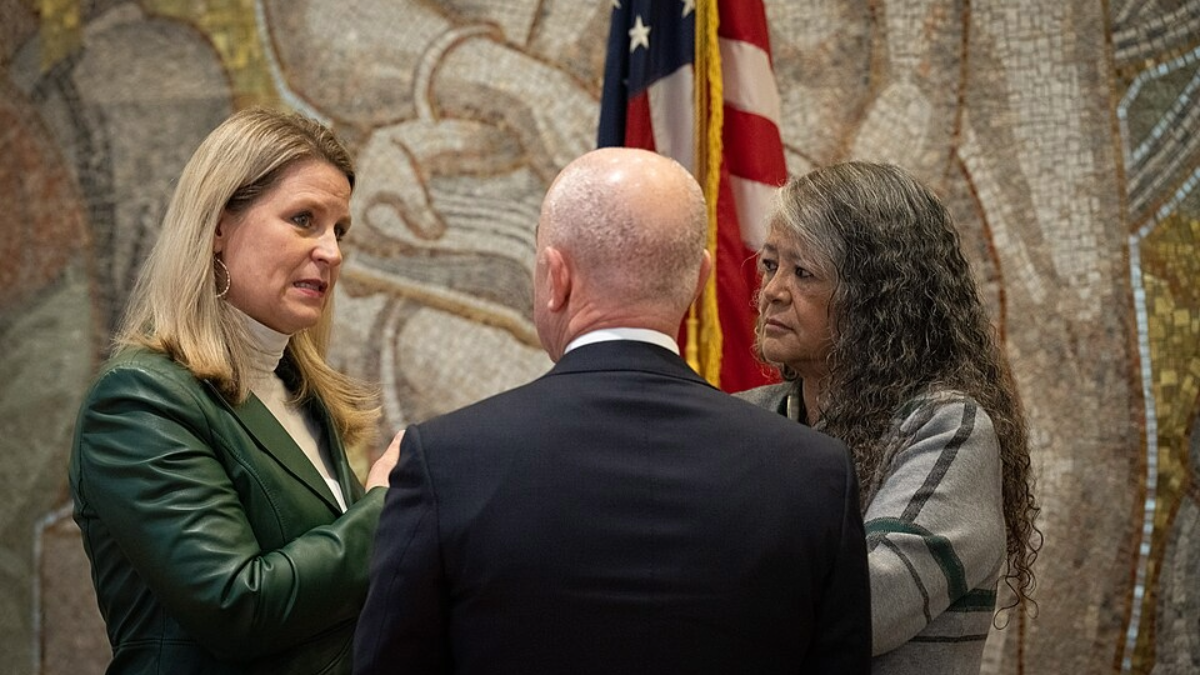How Major Labor Unions are Positioning on AI
Chris Mills Rodrigo / Oct 28, 2025
AFL-CIO President Liz Shuler meets with members of the Biden administration in Washington, DC, on Jan. 13, 2023. (DHSgov)
As industries rush to integrate artificial intelligence tools into their daily operations, labor unions may well serve as workers’ best hope of shaping how this trend affects their jobs. Whether by securing contract provisions, lobbying for protections or resisting major changes, unions are set to play a critical role in the pace and reach of AI adoption across workplaces.
So far, unions in the United States have adopted a fairly consistent tone on AI: that the technology has the potential to improve productivity and benefit society, but workers need to be involved in where and how it is deployed.
The AFL-CIO, a federation of 63 unions representing roughly 15 million workers, typified that posture in a report published earlier this month.
“There is a path where new technology makes work better and safer, with good union jobs that have fair pay and better job quality,” the group wrote. “In this vision, working people have economic security, knowing that companies and public agencies must follow rules to make sure technology such as artificial intelligence (AI) is used safely, responsibly, and fairly.”
While critics have urged workers to approach AI more skeptically, warning that it is the latest in a long line of technologies dating back to the mechanized loom that employers will use to justify cutting labor costs, the AFL-CIO report paints a rosier picture of AI’s potential.
“With workers having a real voice in technology, AI strengthens, rather than weakens, democratic institutions, creating an economy that benefits everyone and ensuring public services are not undermined by improper uses of AI,” the federation wrote.
A key demand across unions is for guardrails on the development and deployment of AI.
Several unions lobbied against a federal proposal that would have barred states from enforcing AI regulations. The International Brotherhood of Teamsters, representing 1.3 million workers across the US and Canada, called it a “power grab by Big Tech — and a direct threat to workers,” while the International Association of Sheet Metal, Air, Rail and Transportation Workers (SMART) said it “would have given big tech companies even more leeway to operate unchecked and with limited accountability.”
Another is that workers have a say in deployment.
A 2023 report from Communications Workers of America emphasized that the union “will not accept that the effects of AI systems are inevitable or pre-determined” and called for reevaluating current contracts as tools are introduced. Service Employees International Union president April Verrett recently wrote that “we must create spaces for worker-led technology adoption that treats human beings with respect and dignity.” The United Food and Commercial Workers union has also stressed the importance of bargaining to ensure AI use that doesn’t threaten jobs.
“People want guardrails, they want the technology to be responsible,” said Kung Feng, a senior researcher at the UC Berkeley Labor Center’s Technology and Work Program, who recently co-published a report analyzing unions’ public statements on AI. “We saw a lot of cohesion around worker voice, that workers and communities who are impacted should be involved in the design and the deployment of technology.”
Unions have also raised alarm about biases in AI and how those could harm workers.
The American Federation of State, County and Municipal Employees has said it will lobby for policies that ensure AI doesn’t “exacerbate discrimination, bias, fraud and the disempowerment of workers.” UNITE HERE testified before the Senate earlier this month that racial and gender biases in AI systems could lead to discriminatory hiring practices.
While labor union’s attitudes toward the technology have broadly been similar, differences have emerged when practical applications of AI have been introduced in unionized workplaces.
One arena where AI’s transformative potential has been highly touted is education.
The National Education Association (NEA) of the United States — with over 3 million members across a litany of public school jobs — released a report last June highlighting how AI could improve learning if used equitably, emphasizing how it needs to adapt to the needs of disabled students.
Adam Aguilera, a sixth and seventh grade English arts teacher in Washington State and a member of the NEA working group that produced the report, said that AI has helped him design curriculum and aided his students with editing their writing.
Aguilera stressed that both students and teachers need better training in how AI works to avoid being left behind by the technology.
“Our institutions and systems are far behind in terms of educating people about it, creating an awareness on how people can even engage with AI much less use it — and in the education system there definitely has been that lag,” he said.
The American Federation of Teachers went a step further by partnering with some of the biggest companies in the space. The 1.8 million member union teamed up with Microsoft, OpenAI and Anthropic this summer to provide free AI training for teachers. The companies are putting a combined $23 million over five years into the effort, which also includes the construction of a facility in New York City called the National Academy for AI Instruction.
Other unions have been less open to AI deployment in their sectors. The Teamsters have been fighting for the past few years against a development that could threaten tens of thousands of workers who make their living behind a wheel: autonomous vehicles.
“We're not against new technology that enhances work, that creates new jobs throughout the supply chain, but simultaneously, if there is new technology being developed — AI driving systems are a perfect example — by big corporations, and the intent of that new technology is simply to automate and eliminate labor costs, and there's not going to be sharing of the prosperity created by the productivity gains with working people, then we're going to stand up,” Teamsters western region vice president Peter Finn told Tech Policy Press.
That battle has largely played out in California, where the union and its allies successfully pushed a bill through the legislature that would have banned self-driving trucks without a human driver aboard, only to be vetoed by Governor Gavin Newsom (D) twice. Colorado Gov. Jared Polis (D) vetoed a similar Teamsters-backed bill this year.
Despite those setbacks, the Teamsters are still trying to pursue regulatory solutions to the threats they see AI posing to their members, Finn said.
Other unions have focused on securing contract provisions rather than legislation to protect against AI. One of the main sticking points during the massive Screen Actors Guild (SAG-AFTRA) and Writers Guild of America strikes of 2023 was the threat of AI being used to mimic the likenesses or written work of members without compensation. The resulting SAG-AFTRA deal included provisions on consent and compensation for digital reproductions, while the WGA agreement set rules for how studios can use AI on human-written content.
SAG-AFTRA has kept up the pressure on AI companies, recently reaching a deal with the video creation app Sora to crack down on content created with the likenesses of actors.
There are also several unions that have stayed relatively quiet on AI.
The United Auto Workers have made little public comment on the technology and contracts that it has struck that do mention it do so briefly. The International Longshoremen’s Association has been similarly mum, although their west coast counterparts in the International Longshore and Warehouse Union have condemned the use of AI to “surveil, discipline, and displace workers.”
Some union members have a lot to gain from the surge in computing and energy demand that AI is driving. “AI, electrification and the clean energy transition have created a historic opportunity to grow the [International Brotherhood of Electrical Workers], and we are taking full advantage of it,” the group’s president Kenneth Cooper wrote in July.
Whether or not the billions of dollars being poured into AI development will yield breakthroughs that change the landscape of US labor, employers are already frequently deploying it, and surveys suggest majorities fear it will displace their labor. How unions approach the technology will be crucial to how that process plays out.
Authors
